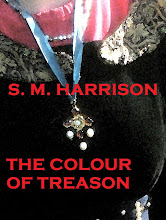A WARWICK! A WARWICK!
It has been a while since I've visited the favourite home of our hero, Richard Neville 16th Earl of Warwick. Warwick Castle came to him, aged 20, as earl of Warwick in right of his wife as part of her Beauchamp inheritance and it seems that Richard identified strongly with the Beauchamp legacy. Keeping possession of the inheritance was however not easy. As Anne de Beauchamp's late brother, duke Henry of Warwick had attained his majority and received livery of his estates, the whole should have passed to his only surviving sister, on the grounds of the exclusion of the half-blood (the half sisters by their father's first wife).
There were three elements: the Beauchamp estates which the new Countess inherited from her brother; the lordship of Abergavenny in which she was also sole heir of her brother; and the Despenser estates, in which she was the joint heir of her mother. There were other elements that Richard Beauchamp had put in Trust. The half sisters did not hesitate to claim a quarter share each of the Beauchamp estates not in Trust, and John Talbot, earl of Shrewsbury, as husband of the eldest daughter Margaret, even had hopes of the title himself! The inquisitions post mortem when eventually held unanimously concluded in every county that Warwick's countess was the sole heir. The sisters continued to contest the decisions and the new earl spent much of his time fighting (at times literally) to keep hold of and even gain estates. The sisters had no claim to the Abergavenny or Despenser lands buyt the descent of these was complex due to the intermarriage of cousins.Warwick annexed all the Despenser lands, even though only half ewre his countess's by right. The earl's possession was endorsed by key Beauchamp councillors, administrators and retainers including Nicholas Rody, Thomas Hugford, and William Berkeswell, dean of St Mary's Warwick who had served Beauchamp since the1420's or earlier. Others also moved to Warwick's service and were key supporters of his countess as sole heir to the Despenser estates.
Warwick spent much of his time residing at Warwick and visiting neighbouring lordships. He enthusiastically adopted the traditions of the earldom, in relation to the bear and ragged staff and the legend of Guy of Warwick as founder of several monasteries, espcially Tewkesbury, as patron of Guy's Cliffe chantry and the collegiate college of St Mary's at Warwick where the famous Beauchamp chapel under the offices of these men, was being built - but that's another post!
Ref: Warwick the Kingmaker Prof A J Pollard Continuum 2007






